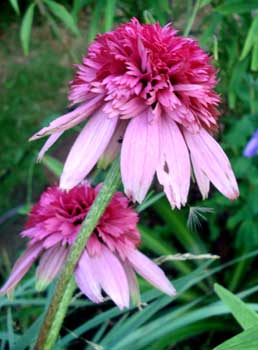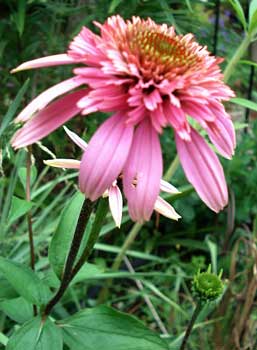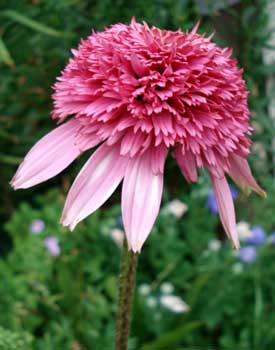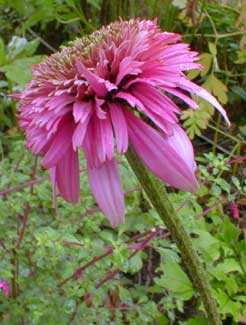
'Razzmatazz'
Double Purple Coneflower
"If there be an Elysium on earth,
It is this, it is this!"
-Thomas Moore
(1779-1852)
(1779-1852)
 The first time I saw 'Razzmatazz' I began lusting for it, I was frozen to the spot, unable to look at any other plant. This was a few years ago, & as a new variety liscensed to few growers, it was just ghastly expensive, but I was completely at its mercy & spent all my lunch money & then some.
The first time I saw 'Razzmatazz' I began lusting for it, I was frozen to the spot, unable to look at any other plant. This was a few years ago, & as a new variety liscensed to few growers, it was just ghastly expensive, but I was completely at its mercy & spent all my lunch money & then some.Advertised as "the world's first fully double echinacea," it is truly & wildly different from any other cultivar of Echinacea purpurea that I'd ever seen. The flowers began mainly as nearly-normal looking singles, the shorter than average flower petals being extra-reflexed around the dark cone. As the cone further matures, it develops small purple flower petals of its own, until it is a dense purple pompom with the regular petals serving as a dangling fringe.
It is just great good luck that this cultivar was saved. The initial grower in the Netherlands, Jan van Winsen who discovered this sport among seedling coneflowers, was a specialist in annuals & cut flowers. He began developing a crop of the very first specimens of 'Razzmatazz' in 1997, but by 2001 had not successfully marketed this unusual sport in his corner of the flower industry, which was focused on cut flowers.
 Convinced there was insufficient interest in it, Jan was on the verge of composting the entire crop. He rather causually mentioned his plan to his friend Marco van Noort while they were row-boating together.
Convinced there was insufficient interest in it, Jan was on the verge of composting the entire crop. He rather causually mentioned his plan to his friend Marco van Noort while they were row-boating together.Marco immediately realized the double-echinacea was a fantastic new breakthrough for the species. He took over Jan's stocks & 'Razzmatazz' was saved from instant extinction. It would in a few short years give rize to further cultivars with similarly distinct form, so would not remain the only variety of its general type; but it's not apt to be displaced, as it is its own perfection for beauty & hardiness.
 When the perennial market learned of this flower's existence, the wild enthusiasm induced the fast-track to get this plant to market. In 2004 it was exhibited in a London flower show with policemen guarding the plants against the too-eager sticky fingers of the public.
When the perennial market learned of this flower's existence, the wild enthusiasm induced the fast-track to get this plant to market. In 2004 it was exhibited in a London flower show with policemen guarding the plants against the too-eager sticky fingers of the public.One year later it was reaching the better independent nurseries in the United States, though stocks were such that seriously inflated prices were being asked. The patient gardener would get them cheaper by waiting a couple years, but I for one couldn't wait.
'Razzmatazz' has a mild fragrance. On Puget Sound, it flowers from July to September or until the first hard frost. It grows thirty inches to three feet tall. As with other purple coneflowers, it wants full sun, is fairly drought hardy, & is an easy perennial for zones 4 through 8. They are long-lasting as cut flowers, but vastly more longlasting left on the clump.
Coneflowers sometimes make a feeble effort to keep blooming right into our mild winters but won't be able to finish the process, so young specimens in particular should have any post-September or winter flower stems cut back, in order to encourage only root development for the first couple of years, & to insure healthy regrowth the following spring.
Continue to:
'Coconut Lime' Coneflower